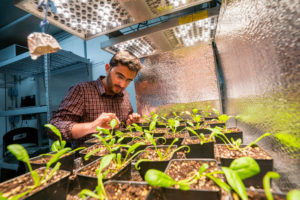Texas A&M AgriLife seeks input on controlled environment agriculture
Grant-funded stakeholder meeting Dec. 5 coincides with annual controlled environment ag conference in Dallas
Developments within Texas A&M AgriLife’s urban agriculture efforts could pave the way for expanded research opportunities and progress in the field of controlled environment agriculture production.

Texas A&M AgriLife Research recently received a U.S. Department of Agriculture grant that could guide federal investment in controlled environment agriculture production in Texas and the U.S.
The urban agriculture advisory committee funded through the grant will hold its first meeting Dec. 5 to coincide with the fourth annual Urban Agriculture: Controlled Environment Conference at the Texas A&M AgriLife Research and Extension Center in Dallas on Dec. 6.
Texas A&M AgriLife scientists at the Dallas center involved in the grant and conference are Azlan Zahid, Ph.D., AgriLife Research assistant professor of controlled environment agriculture engineering in the Department of Biological and Agricultural Engineering; and Joe Masabni, Ph.D., AgriLife Extension horticulturist; Genhua Niu, Ph.D., AgriLife Research professor of urban agriculture; and Daniel Leskovar, Ph.D., interim director of the center at Dallas and a professor of vegetable physiology and plant sciences, all in Department of Horticultural Sciences.
Grant to identify controlled environment agriculture priorities
Zahid said the $50,000 grant from the USDA’s National Institute of Food and Agriculture is a planning grant designed to identify research priorities within controlled environment farming.
The advisory committee meeting and conference will help with planning and priority identification.
Zahid said the first step of the grant was to create the advisory committee made up of growers and industry representatives who will help AgriLife Research identify research needs.
But the grant will also fund online surveys and meetings designed to identify economically viable hydroponic leafy green crops and gauge growers’ interest in adopting new technology in their controlled environment operations.
“We want to develop a comprehensive research plan based on stakeholder challenges and needs,” he said. “There is a lot of interest in controlled environment production and urban farming, and this is the first step toward developing a plan and producing data to justify different research projects in this emerging field.”
Conference welcomes experienced and new growers
The fourth annual Urban Agriculture: Controlled Environment Conference is led by Texas A&M AgriLife Extension Service specialists and AgriLife Research faculty.

Masabni said new and prospective controlled environment growers and hydroponic growers and enthusiasts of all skill levels are encouraged to attend. Register for either in-person or online attendance to the conference at https://tx.ag/UrbanAgConference.
Producers, industry insiders like Hoogendoorn and Eden Green Technology as well as research scientists from academic institutions like Cornell University, Oklahoma State University, University of Arizona and University of California, Davis will be engaged in the discussions, Masabni said.
The registration fee includes a box lunch, catered dinner and a reception. A tour of the center’s greenhouse facilities will demonstrate hydroponic and aquaponic systems in production. For more details, contact Masabni at [email protected].
“The timing of the grant and the conference worked out perfectly,” Masabni said. “This advisory committee meeting and the conference creates a good chance for growers and the industry to connect with academics in the field and identify the challenges and opportunities in urban agriculture.”
Interest in controlled environment agriculture grows
Controlled environment vegetable production is a booming field in the U.S., but the domestic industry is far behind because of a lack of research investment, Zahid said.
He said the USDA views urban controlled environment production as a potential way to directly address food deserts, avoid supply chain disruptions, reduce carbon footprints by removing logistical steps between farms and the market while improving nutritional values with harvest-ready produce for local consumers.
But there are challenges associated with controlling temperature, humidity, light spectrum and carbon dioxide, Zahid said. Engagement with people familiar with controlled environment farming’s pitfalls and potential can help steer the field toward maximizing the latter.
“These discussions and meetings and surveys will help us identify the needs and develop a collaborative network to produce a system-based approach,” he said. “There will be different challenges for industry and individuals, different priorities and different challenges based on things like location, say South Texas compared to North Texas. But this will help us develop a research plan, prioritize projects and submit proposals.”


